The contrast between the ferry terminals in Singapore and Bintan is enormous. Singapore’s terminal was clean and organised whereas the ferry terminal at Tanjung Pinang, the capital city of Kepulauan Riau, was hectic and chaotic and no doubt reflects the administration of each.
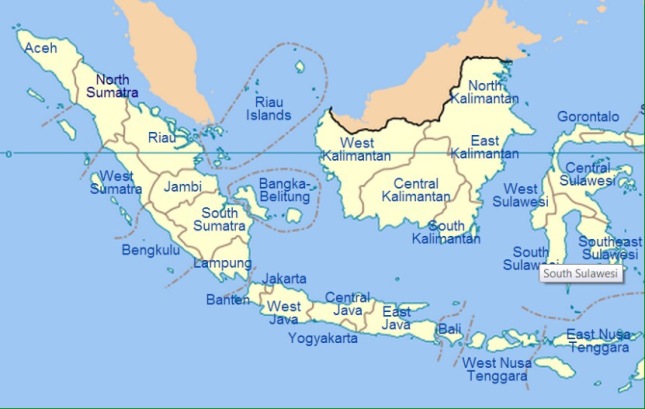 Bintang is one of about 3,200 islands in the Indonesian province of Kepulauan Riau – the Riau Islands. These islands were originally a part of the Riau province on Sumatra but in 2002 they became a separate province. In the 2015 census, the population of the Riau Islands was almost 2 million and according to Wikipedia, is the second fastest growing province in Indonesia. Another interesting fact about the Riau Islands is that they are considered to be the birth place of the modern Malay language!
Bintang is one of about 3,200 islands in the Indonesian province of Kepulauan Riau – the Riau Islands. These islands were originally a part of the Riau province on Sumatra but in 2002 they became a separate province. In the 2015 census, the population of the Riau Islands was almost 2 million and according to Wikipedia, is the second fastest growing province in Indonesia. Another interesting fact about the Riau Islands is that they are considered to be the birth place of the modern Malay language!
After the fall of Malacca in 1511, the Riau Islands became the centre of political power with the sultanate of Johor based on a tiny island just off Bintan called Penyengat Island. This powerful sultanate lasted several centuries until the arrival of Europeans who in their search for a way to control the trade routes through this area, took control of Singapore. In doing this, the British broke the sultanate into 2 parts and thus weakened its cultural and political strength. The arrival of the Dutch was the final nail in the coffin for the sultanate.
Kepulauan Riau is the second largest tourist gateway to Indonesia after Bali! This province saw 1.5 million visitors in 2005 and with the number of ferries options we saw between Singapore and Bintan & Batam, I’m sure the next census will be even more impressive. People come here for many reasons – ranging from visiting historical and cultural sites to relaxing in resorts based near tropical beaches.
Our arrival into Bintan was accompanied by light rain. Thank goodness our suitcases had been checked in because it would have been challenging disembarking in the rain and then navigating through customs and immigration pulling my suitcase. This was my first time entering Indonesia since the abolition of visa payments and it was so straight forward. However finding our way through the building was confusing. It was a true rabbit warren with multiple open doors and no sign clarifying which doorway was the correct one! We ended up outside quite suddenly only to realise that we hadn’t yet collected our suitcases! We tried to make our way back inside as each person we asked gave us a different answer only to be finally told to wait outside and a porter would bring it out. While we stood outside, we were constantly approached by men asking about our transport plans. All were disappointed to hear I had transport arranged. Then someone behind me said my name! I turned and he asked me what hotel I was staying at. This poor fellow had been waiting at the ferry terminal since the earlier morning ferry to meet us! Our luggage arrived finally and we were charged Rp50,000 for them. I was gobsmacked at the inflated price even though we had been warned by both our Singaporean taxi drivers about this. It turns out everything on Bintan is expensive; largely due to the large numbers of wealthy Singaporeans who visit and are prepared to pay these prices. 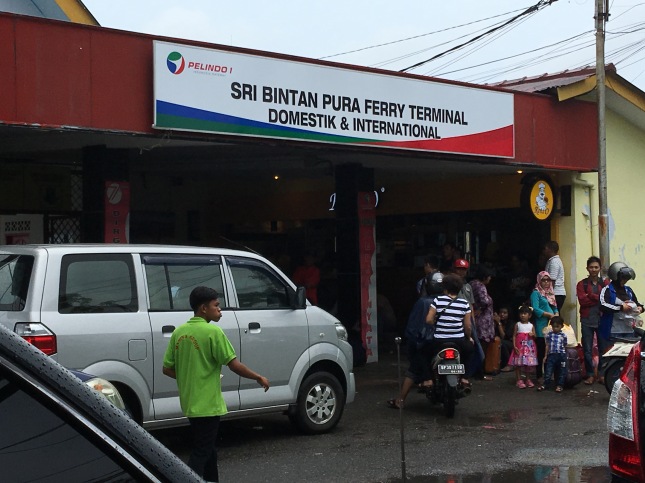
Our drive to our hotel took us from Tanjung Pinang, the capital city of both the island and the province, and then past acres of land clearing and building develoment; apparently land prices here are booming. I’d read online before our arrival that food options around our hotel are limited so I asked our driver to stop off somewhere so we could buy soto ayam (Indonesian chicken soup). It was wonderful sitting in a warung eating soto and rempeyek (a Javanese cracker made with flour, peanuts and small anchovy type fish) and enjoying a cold glass of es jeruk (squeezed local orange juice drink). 
On arrival at our hotel I confirmed that our room had twin beds and was immediately offered a tour of the available rooms so we could choose the one we liked the best. We looked first at the newest rooms behind reception. The smell of paint was still strong, so they certainly were new! Even the ceiling was painted decoratively with clouds! Our tour then took us out along the boardwalk to the other rooms which are situated off the boardwalk over the incoming / outgoing tide. 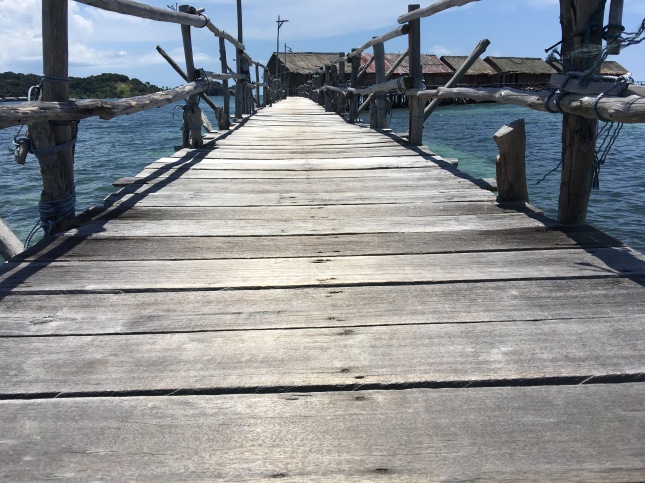 Both room options were suitable however a room with twin beds are only currently available off the boardwalk. Initially we preferred the rooms closer to reception but after our first night, we were very relieved that we had not stayed in one of those rooms as they are closer to the road, closer to the fishing boats heading out early each morning and the generator that was fired up early that evening!
Both room options were suitable however a room with twin beds are only currently available off the boardwalk. Initially we preferred the rooms closer to reception but after our first night, we were very relieved that we had not stayed in one of those rooms as they are closer to the road, closer to the fishing boats heading out early each morning and the generator that was fired up early that evening!
Our room is very basic (some have said rustic) containing 2 single beds, a bedside table, a hand basin, one Singapore power point switch and a fan attached to the wall. The whole room is on an angle as if it is slowly sinking into the sea. Each morning, it felt as though the room had sank a little bit more over night! The bathroom contains a western toilet, a shower, a bucket and dipper. Probably the best feature of the main room is the tiny window opposite the front door. The breeze that comes through this window has been gorgeous. Outside our front door is a verandah alongside the board walk where we can sit and look out at the amazing view. 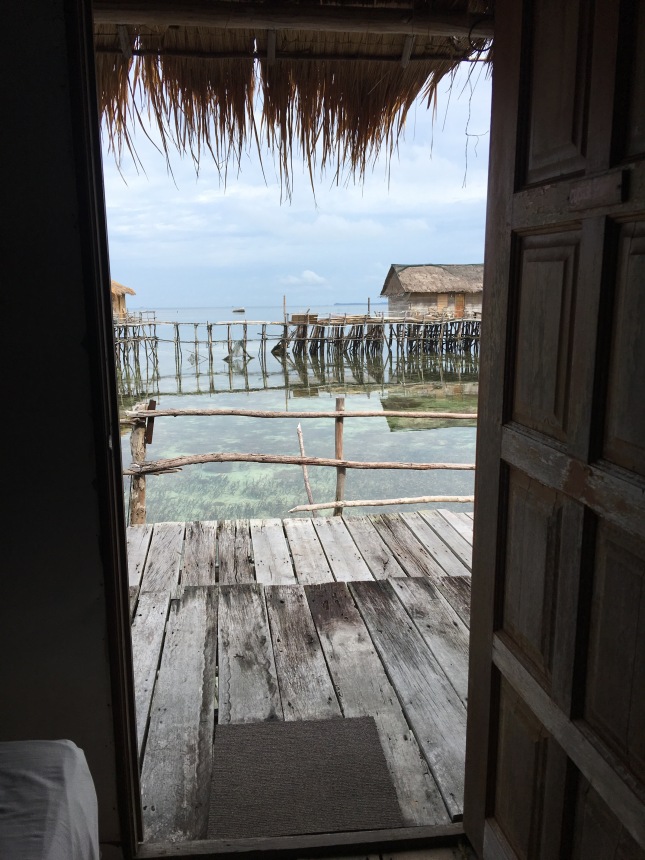 The boardwalk and rooms are all above the sea level and the water below is crystal clear but never particularly deep. At high tide it appears to be about 2 meters and at low tide about 2 feet. Along the boardwalk in the water is old netting and various other oddments that give the small fish somewhere to hide. The best hide though is a pile of huge clam shells and the variety of fish that congregate here is impressive. Our only dilemma with the water quality is that the bathroom plumbing empties directly into the sea below. There are no signs requesting minimal use of soaps or toilet paper unfortunately. Our contribution has been to bin our toilet paper and hope that it doesn’t end up in the sea after our departure.
The boardwalk and rooms are all above the sea level and the water below is crystal clear but never particularly deep. At high tide it appears to be about 2 meters and at low tide about 2 feet. Along the boardwalk in the water is old netting and various other oddments that give the small fish somewhere to hide. The best hide though is a pile of huge clam shells and the variety of fish that congregate here is impressive. Our only dilemma with the water quality is that the bathroom plumbing empties directly into the sea below. There are no signs requesting minimal use of soaps or toilet paper unfortunately. Our contribution has been to bin our toilet paper and hope that it doesn’t end up in the sea after our departure. 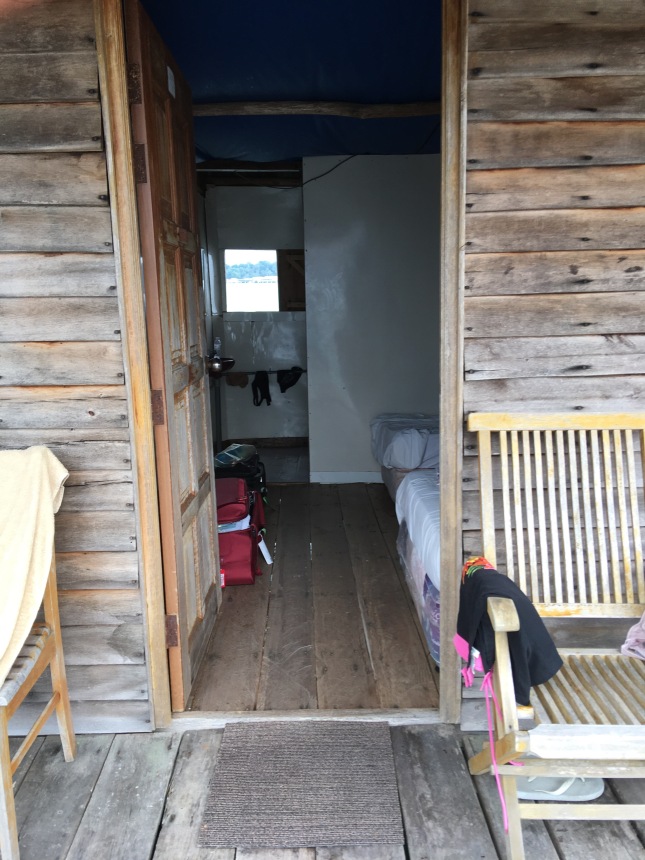
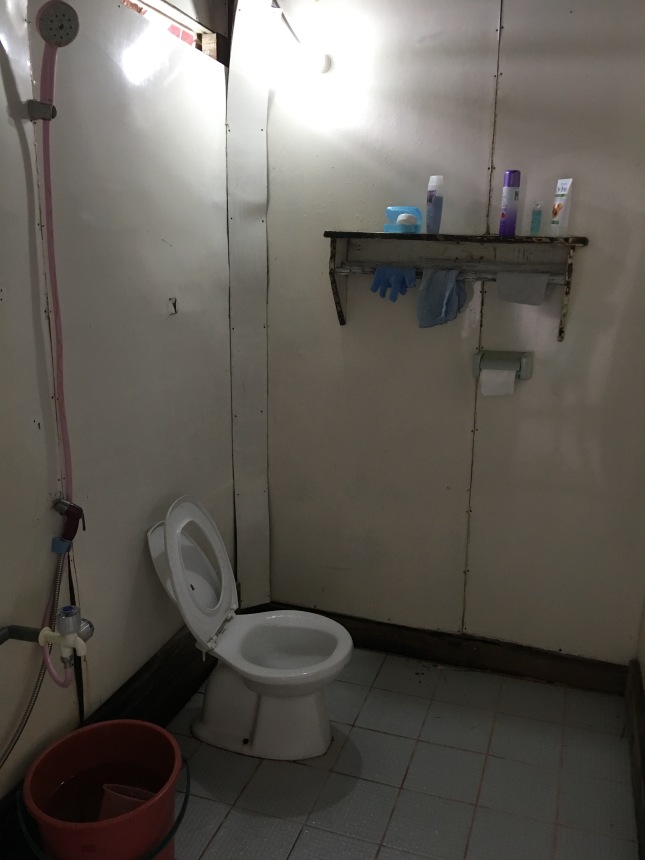
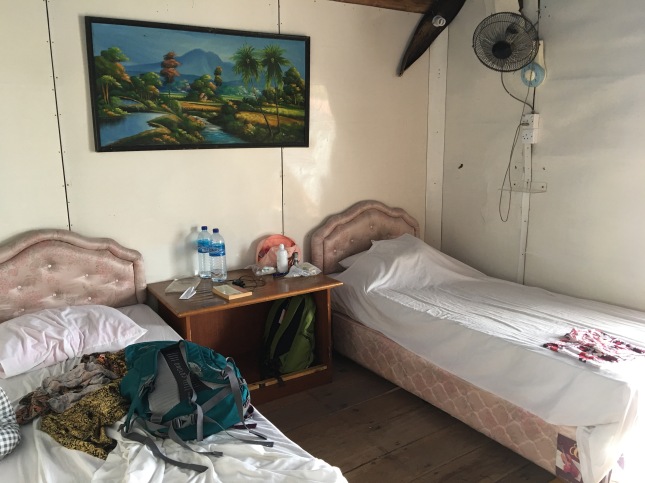
The hotel, Bintan Laguna, was originally built in 2002. It is desperately in need of a major renovation yet it appears the current owners are either unwilling or unable to do so and instead prefer to undertake minor repairs instead. Yesterday a section of board walk was pulled up and replaced, the piers on another room were strengthened with more rope and bamboo and several rooms are having a back verandah added. However, while the rooms are not 5 star, the staff here are absolutely lovely and nothing is too much trouble. The views here too, are stunning. Doesn’t matter what time of day we sit back and look out to sea, we immediately jump up and grab the camera. The light on the water is so picturesque. 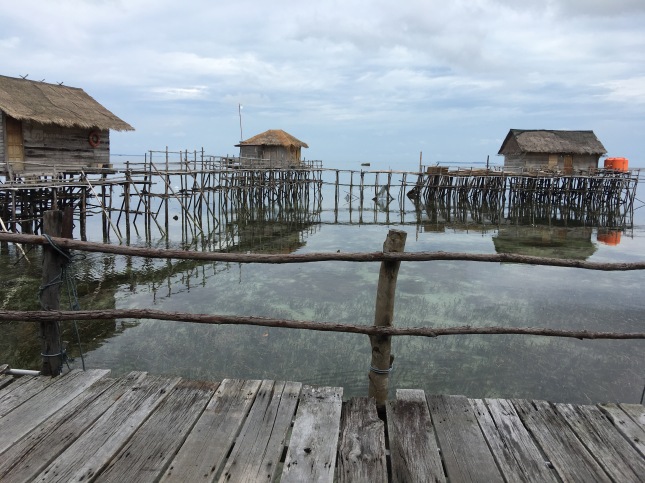
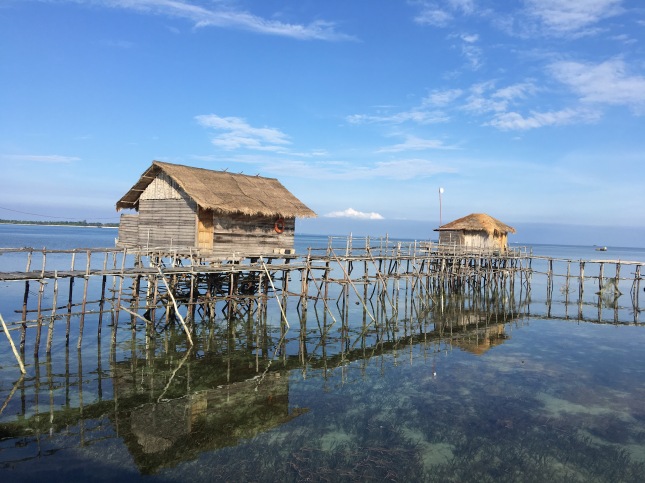
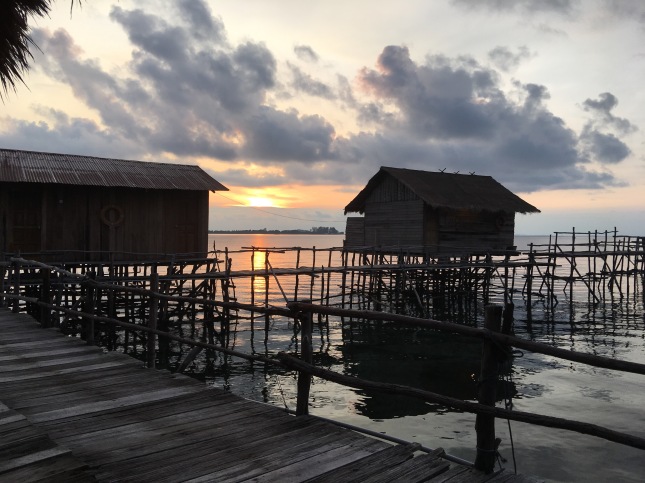
The hotel is in the Trikora district and not close to anything by foot. Visitors to this hotel either have to be totally happy with relaxing and enjoying beautiful views. Otherwise be prepared to fork out a lot of cash to hire a driver or motorbike to take you around. Nothing here is economical beyond the cost of the room. Breakfast is included which includes bottomless tea/coffee from 7-9am but outside these hours food and drink is either unavailable or very expensive at the hotel. Even a can of soft drink costs Rp30,000 (AUD$3). We were advised to buy our water before arriving which we did and saved our selves a small fortune.
At breakfast on our first morning, we met a lovely mother and daughter from Singapore. Melanie and Bu Betty are regular visitors to this hotel because over 10 years ago they owned a hotel here on Bintan which unfortunately failed yet they still have close connections and friends here. They introduced us to Pak Atong, who kindly offered to show us around the following day at local rates. We also met Natalie, a single traveller from France. She asked to join us with whatever we had planned for the day to help cut costs but it turned out that all costs are per person and we saved nothing. Still, it was lovely to spend some time with Natalie as she is also a primary school teacher on holidays!
Natalie explained that the main reason she came to Bintang, was because she’d heard that the beaches here were stunning. She had hoped to laze around on white sandy beaches and swim in turquoise seas, all of which are definitely available in Bintang, just not within walking distance. We tossed up between getting a driver to take us north to a beach recommended by others or go by boat out to White Sands Island just off the coast here. The receptionist said the water would be cleaner off White Sands Island, so we went with that option. Knowing what I now know, it would have been much cheaper to have rented a car and gone north to the beach there, yet I’m pleased we did explore White Sands Island too. It cost us Rp350,000 per person for the trip if we wanted to snorkel on the way or Rp250,000 if not snorkelling. We stopped the boat just off the island to snorkel. The water was a beautiful temperature and very bouyant. It was lovely just lying back in the ocean floating when not snorkelling. The snorkelling was enjoyable but nothing spectacular. The coral is in a very sad state and there were hundreds and hundreds of beautiful black spiny sea urchins. In the centre of of its body was a fluorescent mouth looking body part and around that were 4 sparkling diamond shapes. Quite beautiful yet intimidating with its long spiny prongs and given that the tide was going out, I was not comfortable with the reducing distance between me and the top of their spines!
While swimming, we noticed that a storm was coming in. The sky over Bintan was black with lightening and thunder. We clambeted backninto the boat and headed to White Sands Island and got there just in time. A thunderstorm blew in and all the equipment out on the sand had to be rescued before it blew out to sea. We were ushered into the equipment room as it was the only outdoor space protected from the wind which was very cold on our wet bathers. We sat there shivering while watching an enormous blown up unicorn shuffling to and fro in the wind to while waiting for the nasi goreng and glass of water lunch that was included in the cost of the boat trip.
As we finished eating, the storm finished and we headed outside to explore. The north eastern point of the island is a beautiful sandy beach with azure waters. The beach itself has been set up with all sorts of relaxing ways to pass the time. There were hammocks, lounge chairs, swings, a restaurant, and a shed full of snorkelling and diving equipment as well other water sport options. 4 huts are available for overnight stays and I was quoted Rp288,000 per night. Considering that includes breakfast and the boat trip out, it is very reasonable. The only hiccup is that you have no alternative restaurant options. Food and drink prices were exorbitant. It would be a gorgeous spot to relax for maybe one night. While we were there we saw several groups come and go. Seems to be a popular destination for day trippers too. 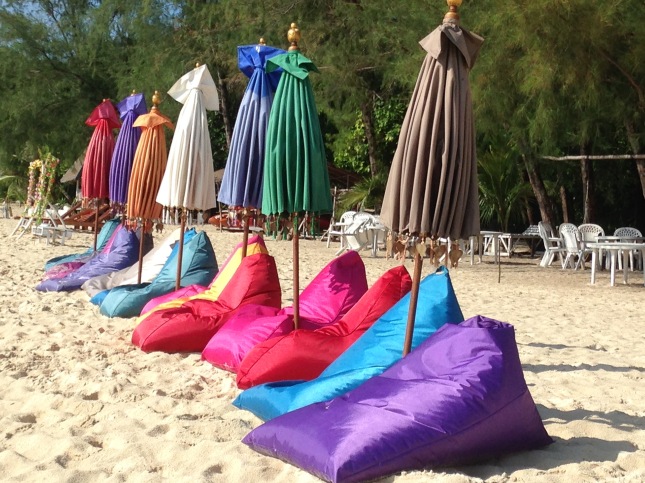

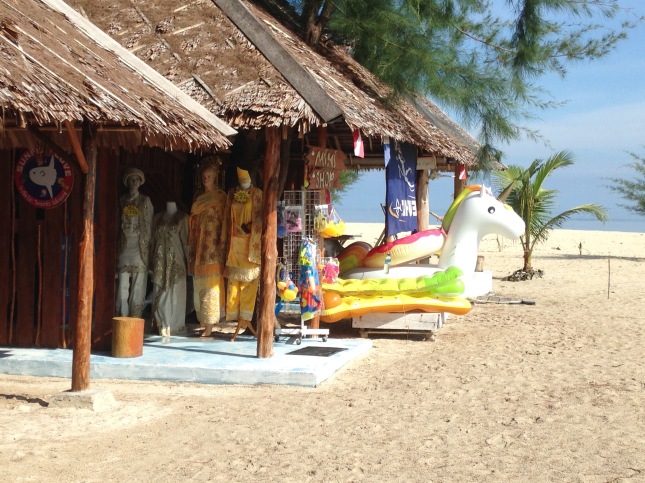
We were told before we arrived at our hotel, that there were no places nearby to eat out. However we have since discovered there are several nearby warungs – lesehan style (a raised hut with a low table in the middle of the floor around which everyone sits). The food hasn’t been spectacular but it is definitely better priced to what is on offer here at the hotel. After our day at White Sands Island, we visited a nearby warung where we ordered ikan bakar (grilled fish) and sat right by the waters edge watching the almost full moon rise, the lights come on in the nearby fishing village as well as millions of huge bats flying from an island across the sea to the mountain behind us. 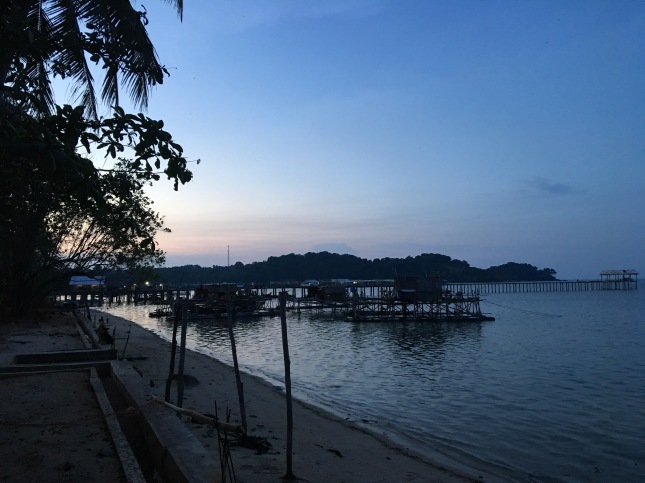
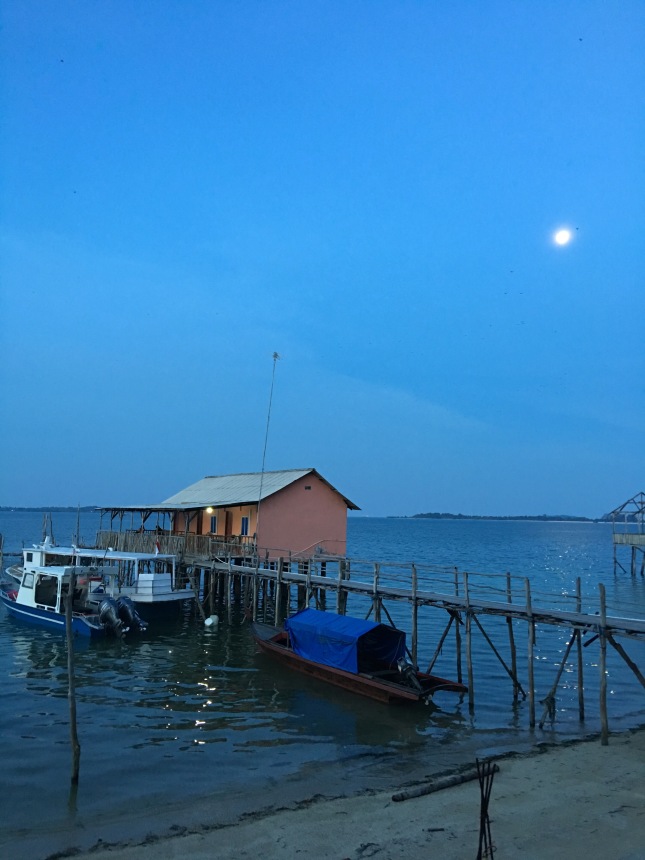
Yesterday Pak Atong collected us and took us for a drive. We began by heading to Lagoi where all the very expensive resorts are located. On the way we stopped to take photos of kelong – fishing vessels that are constructed from timber and float on empty plastic drums.  They are largely a square wooden platform about 2-3 meters off the surface of the sea with a tiny hut in the centre and a light post on 2 sides. Under the platform are several winches of netting. The kelong go out at night to primarily catch ikan bilis (tiny fish). They firstly lower the nets and then turn on the lights. When full, they use a generator to winch up the nets. Pak Atong explained that to build a kelong costs about Singapore $250,000 and this can be recouped in 6 months. No wonder there are thousands of kelong.
They are largely a square wooden platform about 2-3 meters off the surface of the sea with a tiny hut in the centre and a light post on 2 sides. Under the platform are several winches of netting. The kelong go out at night to primarily catch ikan bilis (tiny fish). They firstly lower the nets and then turn on the lights. When full, they use a generator to winch up the nets. Pak Atong explained that to build a kelong costs about Singapore $250,000 and this can be recouped in 6 months. No wonder there are thousands of kelong.
Our next stop was Trikora Tiga. Here we discovered a well kept local secret. A beautiful bay rivalling White Sands Island. Unfortunately it is not within walking distance from our hotel, but would be well worth a days outing. It is obviously a popular spot for locals as there was a lot of rubbish but it didn’t in any way detract from the sheer beauty of the place. I will let the photos speak for themselves. 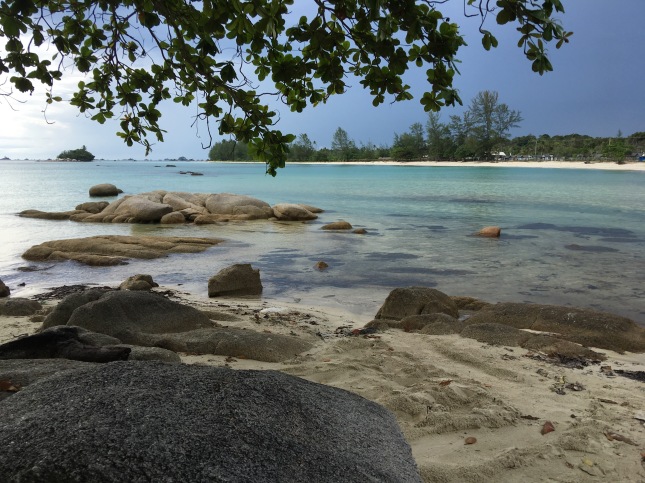

The drive from Trikora Tiga to Lagoi was via a very new road flanked by some of the reddest soil I’ve seen outside the Northern Territory. We passed jungle, swamp, palm oil plantations, villages and land being cleared. With the red soil laid bare after being cleared, it truly looked like the earth was bleeding. To access Lagoi, we had to pass through security before driving down concrete roads with manicured gardens on either side. No wonder this area has been likened with Nusa Dua in Bali. In Lagoi are some of the most expensive hotels on the island but even though it was orderly and manicured, it felt so bleak and lacking in character. We walked around briefly and then headed off to Tanjung Pinang.
On the way, we dropped in to Pak Atong’s family house and property where we saw his ailing dragon fruit vines and then met his beautiful family. We were served with freshly fried banana that melted in our mouths. We were encouraged over and over to eat another and it was impossible to resist. On our departure we were presented with more and they were just as delicious later in the day. The family house was surprisingly cool inside – obviously built to maximise airflow. Inside we met his elderly mother who has limited mobility due to a recent stroke. She was very pleased to meet us even although her Indonesian matched my Mandarin! 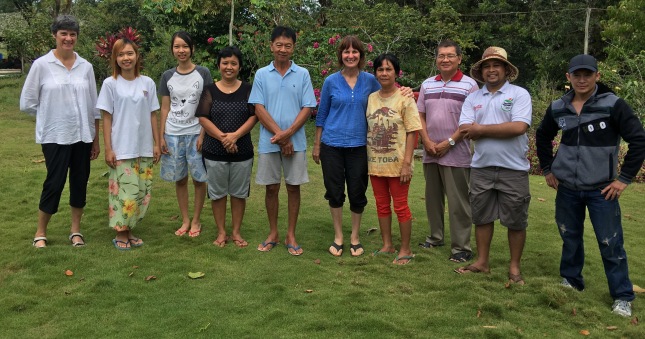
After lots of photos, we headed closer to Tanjung Pinang for lunch. Pak Atong’s wife, Damai, joined us although we did have to go via their home so she could change her shoes. She was wearing her gardening thongs! We ate at a Padang restaurant. The best thing about Padang food is that all the dishes available are displayed in the window. You point to what looks good and then they put portions in a small bowl which the waiter brings to the table. You only pay for the bowls that you tried. So, if eating at a Padang restuarant, don’t try everything unless you are happy to pay for it regardless of whether you had a mouthful or finished the entire bowl. The food was beautiful. We had curried jackfruit, eel, cassava leaves, rice and potato cake. It was a beautiful meal. 
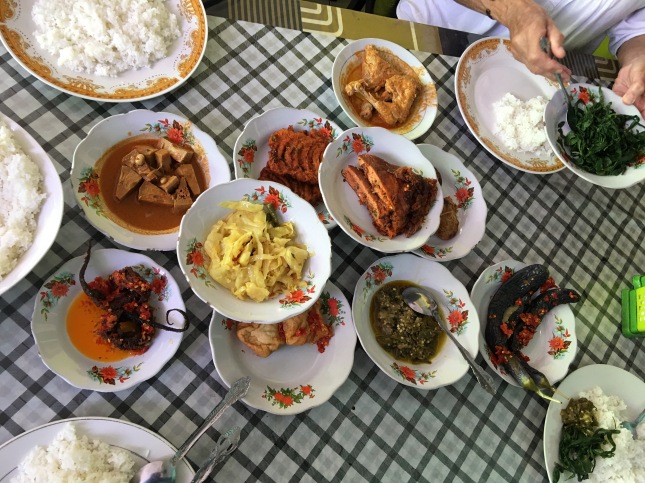
We headed back to the hotel via the Buddhist temple which unfortunately is closed on Mondays. Looked impressive though and sits high up on a hill where the view over Tanjung Pinang would be spectacular.
Overall our trip to Bintan has been very relaxing and we have been very fortunate with the weather. It’s been a lovely way to begin our 2017 Indonesian adventure.
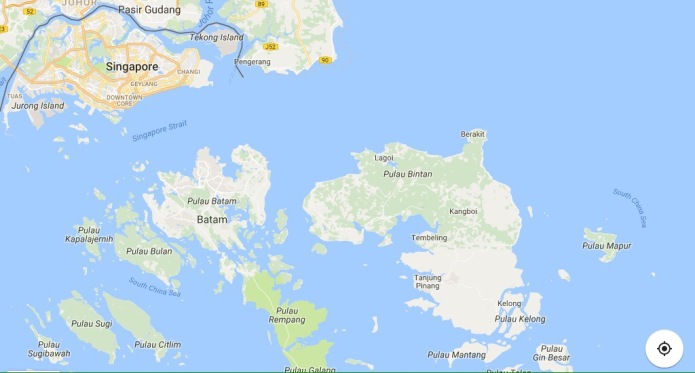
Selamat pagi Bu Cathy!!! All is going well. Thank you so much for all you wonderful preparations. The lessons have been very successful – the children are engaged and I continue to learn a lot from them. We are enjoying almost perfect autumn weather, I hope you have lovely weather also. Please say HI to Marg for me.
Kindest regards,
Christy
Wow! Your descriptions of the beaches reminded me of our time on that island off Padang in sumatra……sounds idyllic°!!
The pics are gorgeous!